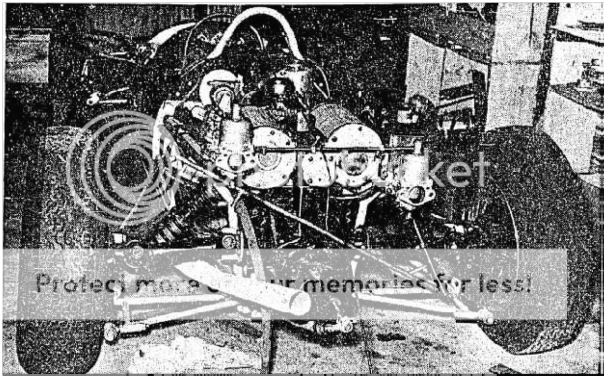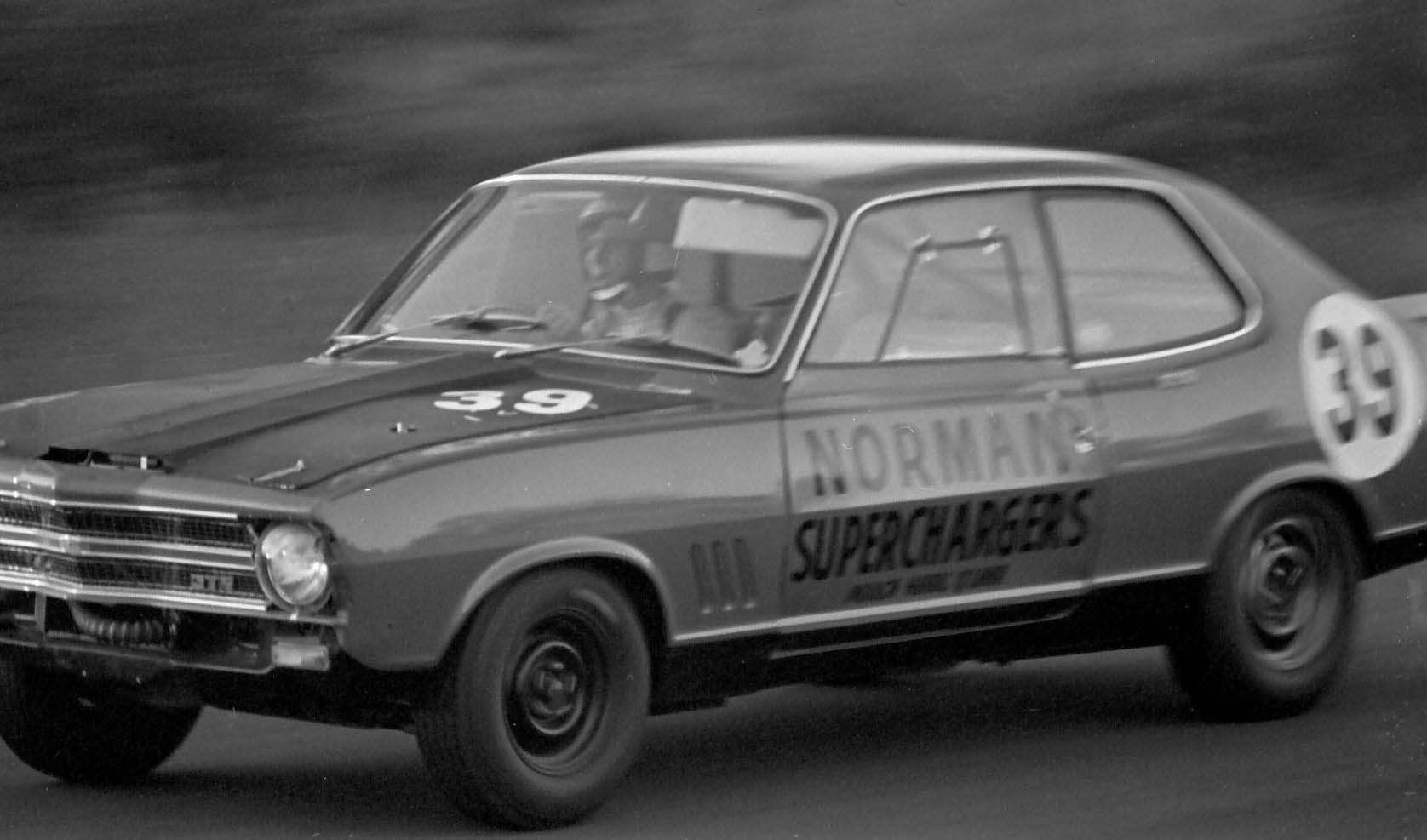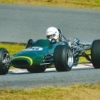Following on from my Norman supercharged landspeed record anecdote, the post below will share a similar story focussed on Speedway Normans. Norman superchargers were also used to some extent in Speedway racing in the 1960’s and 1970’s. This was particularly evident in South Australia, probably due to Eldred’s manufacturing operation being initially centred in Adelaide.
From our earlier Norman supercharged land speed anecdote, remember that Andrew Mustard’s Norman supercharged Elfin cylinder head work was done by Alex Rowe. Alex Rowe was a close associate of Eldred Norman. In the mid 1950’s to early 1960s Alex Rowe had a workshop 9 Eliza Street St Peters, Adelaide. Rowe did a variety of work from this location, including manufacturing and selling floor shifters for early Holden grey motor crashboxes. Part of the workshop was offered to Eldred Norman to manufacture superchargers (Eldred had his workshop in Halifax street). Rowe and his wife Helen later ran the Golden Fleece Service Station in about 1967/1968 at 87 Winston Ave, Melrose Park (now the current Winston Avenue Music Shop), and lived nearby at 130 Morgan Avenue. Eldred’s larrikin nature was well demonstrated one Friday night when he popped around to visit Rowe’s Eliza Street workshop in the early 1950’s... in his supercharged road racing 1936 Maserati Type 6 CM. The South Australian Police were looking for a race car seen coming up King William Street from the Halifax street region... funnily the car ‘vanished’ around Franklin Street!
Rowe began a long association with Norman superchargers by supercharging a £5 Ford Consul three-bearing crank engine in a midget in 1964. Midgets, also known as speedcars in Australia are methanol burning wingless Speedway (dirt track) vehicles. Modern midgets weigh in around 408kg with a 2721cc engine capacity (a little bigger at 3,000cc for standard engines, and a little smaller at 2,000cc supercharged) producing around 360bhp. Historic midgets were around 180-200bhp. Compare that to our trusty naturally-aspirated FB/EK Holden, coming in at 1100kg, with a 2300cc engine producing 75bhp... the historic midget’s that we will discuss below have a power to weight ratio seven times greater.
Rowe’s Ford Consul engine was probably the 1508cc 47bhp engine from the 1951-1956 MKI Consul (rather than the 1703cc, 59bhp 1956-1962 MKII Consul) as the Speedway capacity regulations were for around 2200cc unsupercharged and overhead valved, with 1600cc supercharged. The Norman-blown Consul motored vehicle was the first of the famous yellow SA#2 Speedway midgets, driven for Rowe by Bill Wigzell and is shown in the image below with Wigzell chasing Rex Sandy’s #56 midget in 1966 at the 392-yard Rowley Park Speedway, South Australia.

The article below describes one of Wigzell’s near-wins towards the end of the Consul-motor’s life in the vehicle.
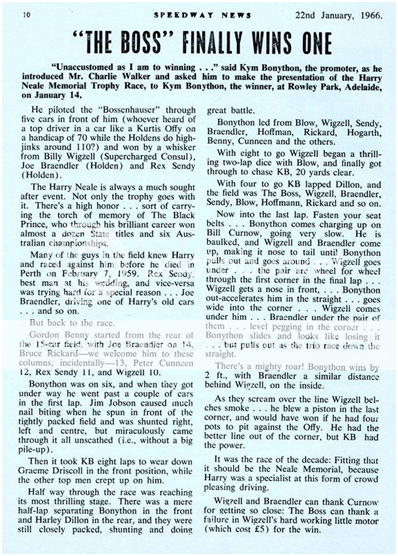
Rowe’s Norman supercharged Ford Consul motor was a real goer but unreliable, and for the 1966/67 season the Consul engine was replaced by a Norman supercharged Peugeot. The yellow SA#2 car (often referred to as the WonderCar) became a crowd hero by taking on and beating the best, including the Americans. After finishing third in the Rick Harvey Memorial behind Kym Bonython and Dean Hogarth, Wigzell won three of the four remaining big races that season - the Harry Neale Memorial, the fourty-lap South Australian State Round of the Craven Filter $6000 National Speedcar Drivers’ Championship and the Golden Fleece fifty-lap Derby. Wigzell won the State Round of the National Championship by more than half a lap despite driving with several slipped discs in his back, and in the fifty-lap Derby took sixteen seconds off the distance record and lapped all but four cars, which included the Americans Bob Tattersall (3rd) and Mike McGreevy (5th) in their Offenhausers.
The cartoons below, drawn by John “Stonie” Stoneham depicts the WonderCar, Wigzell and Rowe in the mid 1960’s.

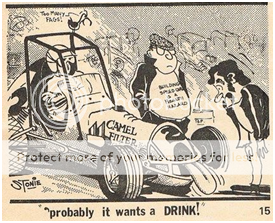
The image below shows Wigzell driving the WonderCar with the supercharged Pug motor in 1966, whilst the image below that again shows Wigzell chasing Bob Tattersell’s McGee Racing Cams Tornado #13 Ford Falcon midget in the same year.
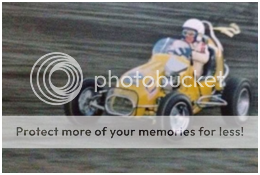
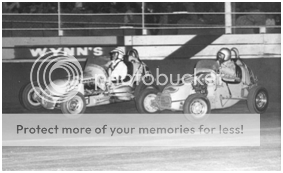
Wigzell continued to drive successfully for Rowe until the car was sold to another driver, Joe Braendler, part way through the 1969/1970 season.
The WonderCar, in it’s restored 1966 Norman supercharged Peugeot guise, is shown below (I’m not sure where the top photo is, but the remainder are from the Adelaide Festival of Speed at Victoria Park Racecourse in April 2014).
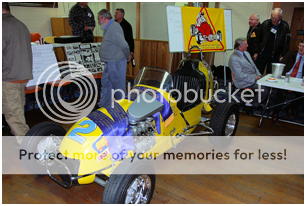
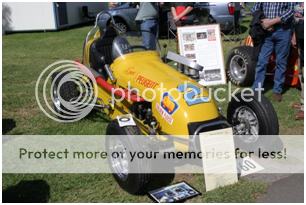
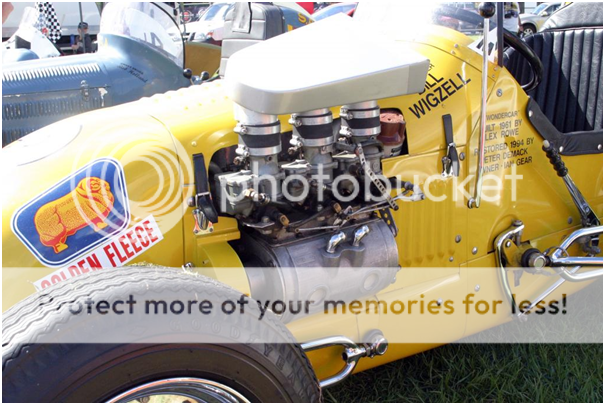
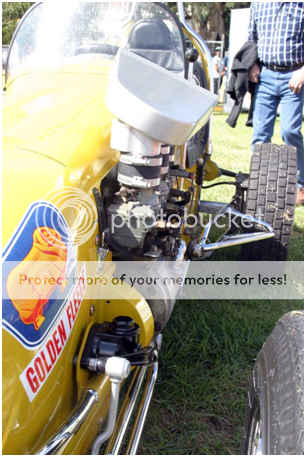
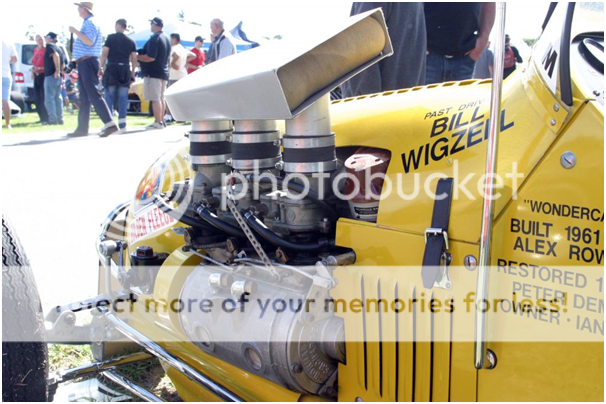
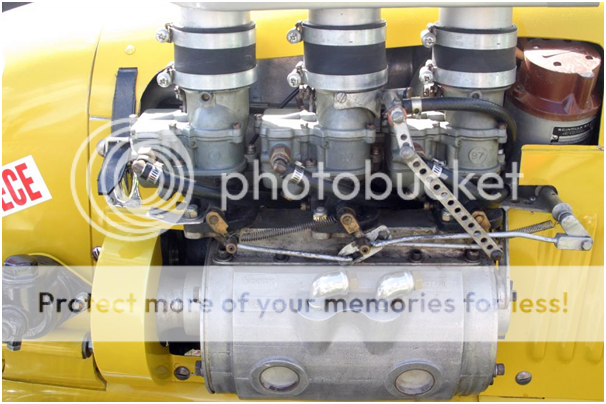

The WonderCar is currently running one of Eldred’s Type 70 superchargers. This is the same supercharger that is run in Peter Wooley's humpy Holden sedan, and Lindsay Wilson's EK Holden wagon. The supercharger can be identified from the model number distinctively cast into the side. Interestingly, the end-plate castings have both "Norman" and "Supercharger" cast into them. The earlier Type 65's have only "Norman" cast into the end plates, which are near-identical to the end plates used twenty years later when Mike Norman started making his extruded-casing machines. The WonderCar Type 70 is a water cooled (jacketed) supercharger, though it appears that the WonderCar runs the jackets dry and plugged off - when running on methanol, temperature increases due to compression and friction are much less an issue than if running petrol. The carburettors are triple Stromberg 97's with a progressive linkage - starting on the centre carburettor and then bringing in the two outer carburettors. This would give approximately 3 x 150 = 450cfm@3"Hg at wide open throttle. Assuming this is the ~1550cc Pug engine, Eldred's basic carburettor guidance would be two off 1¾" SUs (2 x 297 = 594cfm@3"Hg). This would suggest that the triple Strommies may be slightly under-carbed, depending on how much punch the motor is putting out. We will see later that this is a similar problem to that experienced on the Norman supercharged Stud Beasley Peugeot. Note however that the rearmost carburettor on the WonderCar has a linkage that climbs back over the top of the motor. I suspect it may be part of the “extra methanol” setup that Wigzell was reknowned for being able to operate from the cockpit to flood the engine with fuel at full noise.
The Rowe-Wigzell WonderCar speedcar was later driven by various drivers including Colin Hennig, Steve Stewart and was then later powered by a Mazda rotary engine driven by Steve Hennig at Speedway Park. The vehicle is currently owned by Ian Gear, shown below driving the vehicle (back to it’s Norman supercharged Peugeot engine) at the 490-yard Exhibition Grounds Speedway (the EKKA) in Brisbane, Queensland.
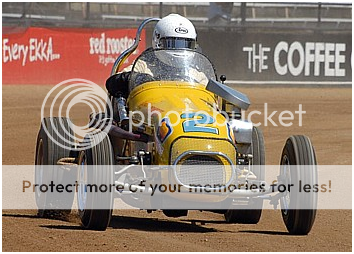
Ian is shown below driving it at a historic meeting at the 390-yard Riverview Speedway, South Australia (also known as Murray Bridge Speedway, or currently the Murray Machining and Sheds Murray Bridge Speedway).
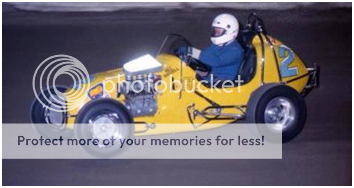
Rowe later went on to build two Norman supercharged Renaults. I am not certain about the first Renault. I know that Greg Anderson drove a supercharged Renault for Rowe, built in 1972 and fitted to an Edmonds chassis, until the closure of Rowley Park in 1979. I’m not sure if this was the first or the second of the Renaults, nor if it was the same car that Anderson won the South Australian Speedcar Championship in the 1973/1974 season.
The second of the two Rowe Renaults was bought by Cec Eichler and was raced under the Kevin Fischer of Murray Bridge South Australia banner alongside the Suddenly #88 Supermodified sprintcar. The norman supercharged midget was also numbered #88 and painted in similar purple as the Suddenly #88 car – see image below. The midget was fitted with fuel injection and looked after by Fischer mechanic Ian Thiele.

Rowe later went on to build a Norman supercharged Volkswagon (which was susceptible to spitting crank cases). Rowe was also the owner of a Norman-supercharged FB Holden, fitted with a floor shifter of his own manufacture.
Bill Wigzell was awarded the Medal of the Order of Australia (OAM) on the 11th of June 1979 for service to the sport of motor racing, whilst Alex Rowe was similarly made an OAM on the 26th of January 1987 for service to speedway racing. This honour is one that they share with the likes of Allan Grice, Craig Lowndes and Mark Skaife.
Another Norman supercharged speedcar was the Stud Beasley Peugeot (VIC#4), which was restored by John Waldock over seventeen years ago. The vehicle was originally built to run a V8 Buick engine, though was deemed by race officials to be overly powered. Stud then changed the motor out to a Peugeot 403 engine (1468cc) before campaigning it. To Stud’s frustration, when raced against the Rowe/Wigzell WonderCar the VIC#4 car came second place... despite the WonderCar running on three of it’s four cylinders. The difference was simple... the WonderCar was Norman blown. Stud made the logical choice, and fitted a Norman supercharger to the Pug motor. Over the years the vehicle went through a number of owners (including a stint as a hill-climb contender), and equally a number of engines – a Coventry Climax, an Alpha Romeo twin-cam, a 1618cc Peugeot 404 (fitted with the Norman supercharger from the Peugeot 403 engine), and also a stroked BMW engine.
Over time the condition of the car deteriorated, and was in a pretty sorry state when John purchased it. John was able to locate the original Peugeot 404 engine and Norman supercharger from Stud’s son Leroy Beasley. The supercharger was approximately 10” long and 4½” internal diameter, is air cooled and has 19 ribs/fins. Given it is purely air cooled and had a steel casing, it is likely to be one of the early Type 65 superchargers.
The supercharger was in very poor condition when John bought it. With little information available to work from, John drew on the memory of Eric Smith (who drove and maintained the car when it was owned by Stud Beasley), together with some photographs – see images below.
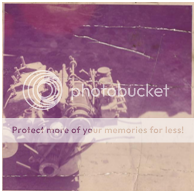
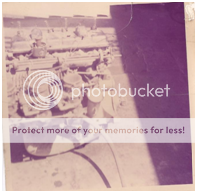
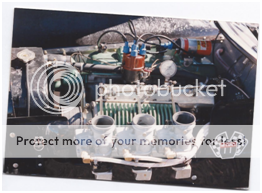
Whilst there were some brackets mounting the supercharger casing, the casing itself was showing signs of corrosion of the hard-chrome liner coating. John had the liner dechromed and honed true to support good oil film retention (John was running castor oil in the fuel to aid in lubrication). The original Norman four-vane steel rotor had been replaced, with the replacement steel rotor incompletely machined at the time of John’s purchase. John made his own rotor from aluminium, drawing from his experience working on rotary vane compressors. John took the opportunity to radius the vane slot ends to remove the stress points incurred by square-edge milling. Interestingly, the end plates have been fitted with thin stainless steel sheeting inserts to prevent wear by the rotor ends. The end plates are fitted with a two piece roller bearing in the drive end, and a ball bearing in the non-drive end (this is the opposite of most Norman superchargers). The end plates and rotor nut were adjusted to achieve a 0.002-0.004” end clearance... considerably tighter than that employed on Judson superchargers (typically 0.010”-0.024”). The vehicle was missing the original manifolds, which John manufactured from the old photos. The inlet manifold runs a common plenum connected to three “fingers”, one for each carburettor. The fingers provided both a mounting point for the carburettors and also moves them outboard into the air flow. The vehicle runs three Stromberg 97 carburettors on a non-progressive linkage as per it’s original trim, though when racing the Beasley family added a fourth carburettor to try and cool the engine down by delivering more fuel (using the huge heat of evaporation of methanol). Like the SA#2 WonderCar, the VIC#4 car was probably marginally under-carburetted when running three Strombergs. The inlet manifold was fitted with a rubber-seated relief valve of approximately 1¾” diameter, set to 15psi. The vehicle typically ran at 8-9psi, though occasionally banged (hiccupped) through the relief valve.
The supercharger was originally fitted with a Gilmer belt drive. During Stud Beasley’s ownership it was noted that when the blower banged, it would snap the belt in short order. Stud rectified this by fitting a chain drive... chains don’t slip, but do transmit all that explosive (banging) force to the crankshaft. The thought of the chain (or worse) letting go certainly played on the mind of the driver at the time, Wayne Pearce. When John remade the vehicle, he reinstated the Gilmer drive belt system, together with a tensioner working from the outside of the belt (as per the original photos above). Initially, John experienced problems with the vanes chipping on one end. A motor mechanic friend who was involved in drag racing looked at it and commented that the belt was on the wrong side of the idler pulley and far too tight. This was causing the rotor to flex thus causing the vanes to chip. Bear in mind that John’s supercharger was running very tight tolerances on end float clearances, so any rotor flex has a substantive effect. After moving the idler to the inside of the belt (and running the belt somewhat looser), the vane chipping issue was resolved. Note that whilst vee-belts must be set very tight to avoid slippage, Gilmer belts are able to be run a lot looser due to their teeth meshing with the pulley teeth.
The photos below show the car being driven by John after being rebuilt.
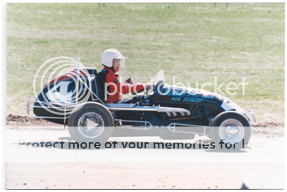

The vehicle was later sold to Cyril Robinson, who then sold the vehicle to Peter Nunn. The pictures below are of Peter driving the vehicle.
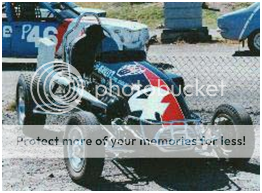
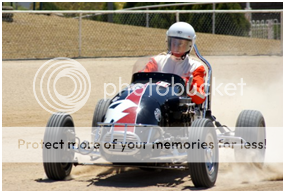
Another Norman-blown midget was SA#75, which was originally built by Rex Hodgson. The Mitsubishi Sirius 4G62T engine was a 1795cc (80.6mm bore x 88mm stroke) single overhead cam eight-valve unit in relatively stock form, taken from a turbocharged Mitsubishi Cordia GSR (1983-89, 135hp in it’s factory turbocharged form). When owned by Hodgson the SA#75 car was running an 80ci/rev Magnusson supercharger and fuel injection unit. It is believed that the Magnusson supercharger and injection were purchased as a unit from the United States, implying that the Norman supercharger and Hilborn injection (that I now own) were fitted to the Cordia engine by a later owner. The Norman supercharger is one of Mike Norman’s 300mm units.
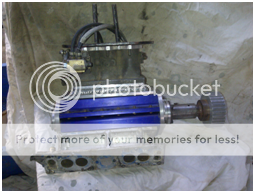
Hodgson ran the Magnusson-blown Mitsubishi engine for only eight to ten meetings around 1985-87, as the supercharger had the tendency to melt drive belts. The car was then sold to Don Cave (from Highlander Crash Repairs in Holden Hill, South Australia), who jointly owned the unit with Colin Hennig. The car was driven by Steve Hennig and Ron Gates. Sadly, both Colin and Steve have passed away. I know that both the injection and the Norman were fitted to the car when Cave/Hennig owned it, and have spoken to both Gates and Bill Ahang, who worked on the Norman at the time. It’s possible that Hennig swapped the Norman and injection onto the Mitsubishi, as Gates remembers a snout being broken (probably the Magnusson’s snout, leading to it’s replacement with the Norman supercharger). The car was later purchased by Max Monk and subsequently parted out. Some parts were sold to Rob Gilbert, with the supercharger and injection going to the Wilsons at Tailem Bend before I bought it.
Another Norman supercharged speedcar was the SA#20 orange midget shown below.
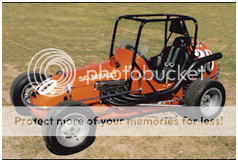

This vehicle was built by Colin Cornelius and raced from 1972 until the closure of Rowley Park in 1979. The vehicle then sat idle until being purchased by Ian Gear in 1985, and remains in original unrestored condition. The vehicle has an all-aluminium 1565cc Renault 16TS engine (83bhp in naturally-aspirated trim), replete with the original hemispherical cross-flow head. The vehicle is fitted with a Type 70 Norman supercharger, being fed by two 1½” SU carburettors (~400cfm@3”Hg). This is slightly under Eldred’s recommendation of two 1¾” SUs (~600cfm@3”Hg), though is dependent on how heavily worked the Renault engine is. The SA#20 vehicle was successful, winning the Harry Neale Memorial when driven by Peter Maltby in 1971.
Some additional Norman supercharged speedway cars that I am aware, but have not been able to chase down include:
a) the Ron Ward as NSW#3 Peugeot speedcar. As far as I know, this was driven at one stage by Brian Mannion car, as shown below:
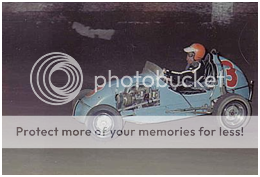
b) Ken Tabe’s supercharged Peugeot, which was last seen in the Northern Territory.
c) Alf Kamilow’s supercharged Hillman Hunter,
d) Kevin Cook’s supercharged Ford Telstar. This vehicle was sold to Des James who drove it for one night at Speedway Park and wrote the car off.
e) Colin Kane’s supercharged Peugeot, and
f) Gary Dillon’s supercharged Volkswagen. I am not sure if this vehicle is related to the Volkswagon supercharged by Alex Rowe, nor if it is related to the Volkswagon that was supercharged by Eldred Norman around 1969 for speedway use in Brisbane (that vehicle had a habit of throwing sparkplugs into the crowd!)
Cheers,
Harv (deputy apprentice Norman supercharger fiddler).































